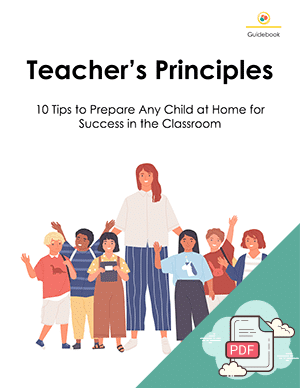- Home
- »
- Family Bonding Challenge
- »
- Building Strong School Partnerships:...
Building Strong School Partnerships: A Parent’s Guide to Supporting Your Child’s Success

Age: 5+
Time: varies
Materials: phone or email access
Focus: communication
School involvement, like so many parenting topics, can be divisive. Some find it an exciting opportunity while others find building strong school partnerships to be another bullet point on an already crippling to-do list.
When the new school year rolls around, most of us are already juggling seventeen different things before we’ve even had our morning coffee (mushroom, classic drip, pod, or otherwise.) The thought of being “involved” at school can feel about as realistic as completing a home renovation project in a weekend.
But here’s the thing: despite your packed schedule and the fact that you can barely keep track of picture day (again!), being an involved parent really does make a difference. And no, this doesn’t mean you need to become the Pinterest-perfect room mom who hand-makes themed snacks.
It’s about building strong school partnerships through whatever parent-teacher collaboration you can realistically manage. Sometimes that looks like responding to emails in your car during soccer practice, and that’s really okay.
These meaningful school partnerships aren’t just about occasional check-ins or showing up to every novelty fundraiser (thank goodness). They’re about creating a supportive network that helps your child thrive academically, socially, and emotionally, without requiring you to quit your day job or master the art Japanese bento lunches.
Why Parent Involvement in the Classroom Matters More Than Ever
Research consistently shows that when parents are actively engaged in their child’s education, students tend to:
- perform better academically;
- have improved behavior; and
- develop stronger social skills.
But developing effective school partnerships goes beyond helping with homework or attending school events. It’s about becoming a true partner in your child’s learning journey through meaningful school partnerships.
When you’re involved in classroom activities, you gain valuable insights into how your child learns best, what challenges they face, and where they excel. This firsthand knowledge helps you better support their learning at home and communicate more effectively with teachers about your child’s needs.
Your presence in the classroom also sends a powerful message to your child that education is a priority. Kids whose parents are visibly invested in their schooling tend to have higher motivation, better attendance, and more positive attitudes toward learning.
Becoming Your Child’s Advocate While Supporting Teachers
Being your child’s advocate doesn’t mean being adversarial with teachers—quite the opposite. The most effective school partnerships are built when parent advocates work collaboratively with educators to ensure their child’s needs are met.
Strong school partnerships require trust, communication, and mutual respect. Here’s how to strike that balance:
Start with trust and respect
Approach teachers as partners in your school partnerships, not opponents. Remember that most educators chose their profession because they genuinely care about helping children succeed. When concerns arise, frame conversations around shared goals for your child’s success to strengthen these school partnerships.
Come prepared with information
If you’re advocating for specific accommodations or support, bring documentation and concrete examples. Teachers appreciate when parents can clearly articulate their child’s needs and provide helpful context about what works at home.
Offer solutions, not just problems
Instead of simply pointing out issues, come to discussions with potential solutions or suggestions. Ask teachers what resources they need to better support your child, and offer to help where appropriate.
Follow the chain of communication
Start conversations with your child’s teacher before escalating to administrators. Most issues can be resolved at the classroom level when approached with patience and collaboration.
Ways to Strengthen School Partnerships Through Parent-Teacher Collaboration
There are five simple ways to make sure your parent-teacher communication is strong throughout the school year.
-
Meet your child’s teacher.
Meeting your child’s teacher doesn’t mean you have to volunteer in the classroom. It does mean that you should try to have a face-to-face meeting with the teacher, though.
Some schools make this easy by having an orientation before school starts or a back-to-school night. Some will have parent-teacher conferences. If your child’s school offers any of these, make sure you figure out a way to attend at least one.
If the allotted time doesn’t work for your family, get in touch with the teacher and see if you can set up another time to come in, even if it’s just for a few minutes. Having at least one in-person meeting will give you the initial connection you need to create a working relationship with your child’s teacher.
-
Find out their preferred method of communication.
When you meet your child’s teacher, find out the best way to communicate with them. Then let them know you want to support them and your child throughout the year.
If they know you’re interested in what happens at school, they’ll be more likely to reach out if any issues arise. You’ll also know the best way to get ahold of them if you need to let them know about something at home that you feel may impact your child’s time at school.
-
Ask how you can best support your child.
Depending on your child’s comfort level with the material covered, you can ask the teacher where you can find information to support your child if they need help or are struggling. If your child seems bored with the material they’re learning about, ask if there are additional learning opportunities to help keep your child interested.
-
Encourage your child to talk with their teachers.
Let your child know it’s okay to ask questions and talk with their teacher if they are unsure about something. The earlier your child learns to speak up for themselves, the better they’ll be able to help themselves throughout life.
It can be hard for some children, though. If you believe your child is hesitant to ask questions, let them know it’s okay to talk with their teacher and ask for clarification.
You can also let their teacher know they are working on speaking up for themselves and ask the teacher to help encourage or help them.
-
Stay informed about progress reports.
Find out how your child’s teacher handles progress reports, grades, and scores. Do they give feedback, either verbally or in writing, to your child? Do they talk with your child about their goals or progress for the year? Is there an online system you or your child can access during the year to see how they are doing? Will the teacher notify you if things are consistently not turned in?
The sooner an issue with poor grades or uncompleted assignments is caught, the less work it will take to repair. If you or your child are not aware until the end of the semester, there won’t be time to catch up.
Supporting Teacher’s Classroom Needs
Understanding and supporting your child’s teacher’s needs creates a positive environment that benefits everyone and strengthens school partnerships. Teachers often face large class sizes, limited resources, and increasing demands on their time. Here are practical ways to support them while building lasting school partnerships:
Respect classroom policies.
Follow through on homework expectations, dress codes, and behavioral guidelines at home. When children see consistency between home and school expectations, it makes the teacher’s job easier.
Volunteer strategically.
Ask teachers specifically what help they need rather than assuming. Some teachers love parent volunteers for field trips, while others prefer help with at-home projects like cutting out materials or organizing supplies.
Communicate timing preferences.
Find out when teachers prefer to receive emails or phone calls. Many appreciate a heads-up if you need to discuss something complex, rather than catching them off-guard before or after school when they’re focused on other tasks.
Show appreciation
A simple thank-you note or acknowledgment of extra effort goes a long way. Teachers often invest their own time and money into creating positive learning experiences for students.
Creating Lasting School Partnerships
The strongest school partnerships develop over time through consistent, positive interactions. Don’t wait for problems to arise before reaching out to nurture these school partnerships.
Regular check-ins, celebrating successes together, and maintaining open communication channels throughout the year create a foundation of trust that benefits your child immensely.
Remember that building these school partnerships is an investment in your child’s entire educational experience.
The collaboration skills you model and the school partnerships you build this year will serve as a template for successful school relationships throughout your child’s academic journey.
If it just isn’t possible to have a face-to-face meeting, contact the school to find out from them what the teacher’s preferred method of contact is.
Once you know that, contact the teacher to let them know or ask the above things. Communication is key and the basis for any good relationship.
When you have strong parent-teacher collaboration and meaningful school partnerships, you’ll be able to make sure your child gets the education they need this year.
Family Bonding Challenges focus on building stronger connections within your family while helping your children learn important life skills. When you subscribe, you will get a fresh calendar each month filled with ideas for celebrating fun family holidays and unique weekly activities.
Carolyn Savage
Carolyn is a writer, proofreader, and editor. She has a background in wildlife management but pivoted to writing and editing when she became a mother.
In her "free time" she is a 4th Dan (degree) Kukkiwon certified black belt in Taekwondo, loves learning to craft from her enormously talented children, and then teaching what she's learned to her enormously talented grandmother. Read full bio >>



